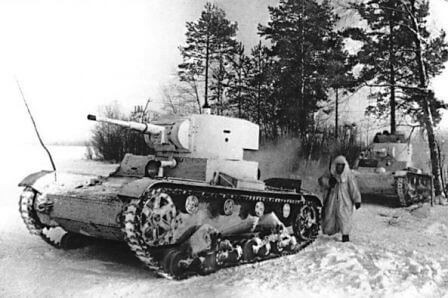
| Year | June 1933 |
| Vehicle Type | Light Tank |
| Origin & Designer | [@designer] |
| Numbers Produced | 5.500 |
| Crew | 3 (Commander, Gunner & Driver) |
| Main Armament | 1 x 45mm L/46 M1932 20K Gun |
| Main Armament | [@sponson_traverse] |
| Elevation | -10° to +40° |
| Turret Traverse | 360° (Manual) |
| Gun Traverse | [@gun_traverse] |
| Gun Mount | [@gun_mounts] |
| Maximum Range | [@maximum_range] |
| Armour Penetration | [@armour_penetration] |
| Gun Sight | T.O.P. |
| Secondary Armament | 2 x 7.62mm DT Machine Guns (Coaxial & Turret Rear) |
| Smoke Discharger | [@smoke_discharger] |
| Ammunition Carried | 100 x 45mm & 2000 x 7.62mm |
| Height | 2.41m |
| Width | 2.39m |
| Length | 4.62m |
| Combat Weight | 4.900 kg |
| Ground Clearance | 0.38m |
| Fording Depth | 0.76m |
| Trench Crossing | 1.80m |
| Obstacle Clearance | 0.70m |
| Climbing Ability | 40° |
| Radio | 71-TK-1 |
| Armour | Hull Front: 15mm Hull Sides: 15mm Hull Rear: 15mm Hull Top: 6mm Hull Bottom: 6mm Gun Mantle: 15mm Turret Front: 15mm Turret Sides: 15mm Turret Rear: 15mm Turret Top: 10mm |
| Engine | GAZ T26 (Petrol) |
| Transmission | 5 Forward & 1 Reverse |
| Maximum Road Range | 175 km |
| Maximum Cross Country Range | 116 km |
| Maximum Water Range | [@maximum_water_range] |
| Maximum Road Speed | 32 kph |
| Maximum Cross Country Speed | 17 kph |
| Maximum Water Speed | [@maximum_water_speed] |
| Variants | [@variants] |
| Notes | The T-26 had many similarities to the Vickers 6 ton tank, mainly to do with the chassis. It initially had twin turrets and mounted machine guns, but by 1933 a version mounting a single turret was produced. The T-26 M1933 was armed with a 45mm main gun, which was considered to be one of the best tank guns designed at that time. Some command versions carried radios which were fitted with distinct hand rail antenna which ran around the rim of the turret. It saw extensive use in the 1930s and in the early years of world war two, mainly as a light infantry tank. |